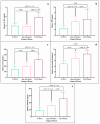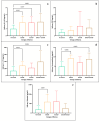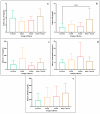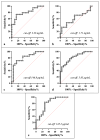Assessment of Salivary Biomarkers of Gastric Ulcer in Horses from a Clinical Perspective
- PMID: 40805041
- PMCID: PMC12345524
- DOI: 10.3390/ani15152251
Assessment of Salivary Biomarkers of Gastric Ulcer in Horses from a Clinical Perspective
Abstract
This study arises from the search for non-invasive diagnostic alternatives for equine gastric ulceration (EGUS), which is prevalent, clinically variable and only confirmed by gastroscopy. The aim is to quantify five salivary biomarkers (IL1-F5, PIP, CA VI, serotransferrin, albumin) under clinical conditions by validated assays and analyse their diagnostic value. Horses were grouped in No EGUS (neither clinical signs of EGUS nor gastric lesions), EGUS non-clinical (apparently no clinical signs of EGUS but with gastric lesions), and EGUS clinical (obvious clinical signs of EGUS and with gastric lesions). The concentration of 5 analytes could be quantified using sandwich ELISA assays, with high precision (CV: 6.79-12.38%) and accuracy (>95%). Mean salivary levels of IL1-F5, CA-VI, serotransferrin and albumin were significantly higher in EGUS clinical horses compared to No EGUS horses, whereas PIP showed no statistical significance. EGUS non-clinical horses showed statistical differences with No EGUS horses for PIP and albumin. In addition, IL1-F5, CA-VI, serotransferrin and albumin showed moderate accuracy to distinguish between No EGUS and EGUS clinical horses (AUC ≥ 0.8), with sensitivity and specificity greater than 77% and 65%, respectively. Therefore, these biomarkers could be a promising starting point for screening horse that might have EGUS in practice.
Keywords: diagnostic value; gastric ulceration; horse; markers; quantification; saliva.
Conflict of interest statement
I.R.I. receives consulting fees from Biozyme Incorporated. L.W. was employed by Biozyme Incorporated. These competing interests do not affect the integrity of the study. M.M.-Q. & A.M.G. are researchers who investigated biomarkers that are subject of patent. C.G.-P. declares no conflicts of interest. The results of this study are protected under US patent application USPTO 63/718,379, owned by Biozyme INC.
Figures





Similar articles
-
Prescription of Controlled Substances: Benefits and Risks.2025 Jul 6. In: StatPearls [Internet]. Treasure Island (FL): StatPearls Publishing; 2025 Jan–. 2025 Jul 6. In: StatPearls [Internet]. Treasure Island (FL): StatPearls Publishing; 2025 Jan–. PMID: 30726003 Free Books & Documents.
-
Signs and symptoms to determine if a patient presenting in primary care or hospital outpatient settings has COVID-19.Cochrane Database Syst Rev. 2022 May 20;5(5):CD013665. doi: 10.1002/14651858.CD013665.pub3. Cochrane Database Syst Rev. 2022. PMID: 35593186 Free PMC article.
-
Blood biomarkers for the non-invasive diagnosis of endometriosis.Cochrane Database Syst Rev. 2016 May 1;2016(5):CD012179. doi: 10.1002/14651858.CD012179. Cochrane Database Syst Rev. 2016. PMID: 27132058 Free PMC article.
-
Automated devices for identifying peripheral arterial disease in people with leg ulceration: an evidence synthesis and cost-effectiveness analysis.Health Technol Assess. 2024 Aug;28(37):1-158. doi: 10.3310/TWCG3912. Health Technol Assess. 2024. PMID: 39186036 Free PMC article.
-
Comparison of Two Modern Survival Prediction Tools, SORG-MLA and METSSS, in Patients With Symptomatic Long-bone Metastases Who Underwent Local Treatment With Surgery Followed by Radiotherapy and With Radiotherapy Alone.Clin Orthop Relat Res. 2024 Dec 1;482(12):2193-2208. doi: 10.1097/CORR.0000000000003185. Epub 2024 Jul 23. Clin Orthop Relat Res. 2024. PMID: 39051924
References
Grants and funding
LinkOut - more resources
Full Text Sources
Miscellaneous

